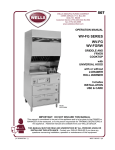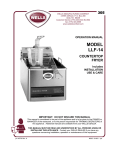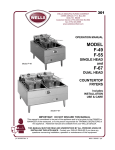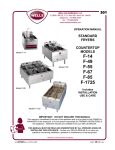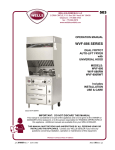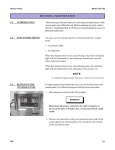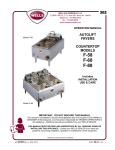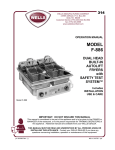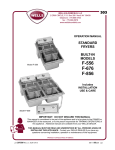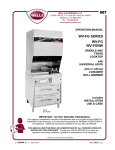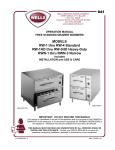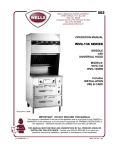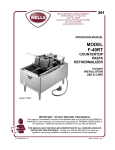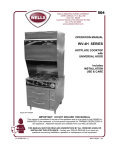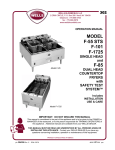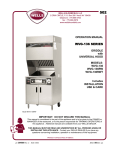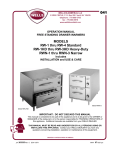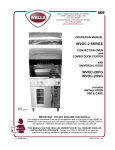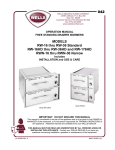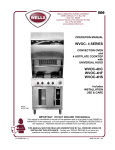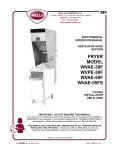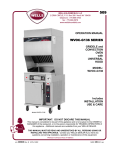Download Wells WVF-886 User's Manual
Transcript
503 OPERATION MANUAL WVF-886 SERIES DUAL AUTO-LIFT STS™ FRYER with UNIVERSAL HOOD Includes INSTALLATION USE & CARE Model WVF-886 IMPORTANT: DO NOT DISCARD THIS MANUAL This manual is considered to be part of the appliance and is to be given to the OWNER or MANAGER of the restaurant, or to the person responsible for TRAINING OPERATORS of this appliance. Additional manuals are available from your WELLS DEALER. THIS MANUAL MUST BE READ AND UNDERSTOOD BY ALL PERSONS USING OR INSTALLING THIS APPLIANCE. Contact your WELLS DEALER if you have any questions concerning installation, operation or maintenance of this equipment. PRINTED IN UNITED STATES OF AMERICA p/n 304989 Rev. B ECN-12660 M503 040318 cps LIMITED WARRANTY STATEMENT Unless otherwise specified, all commercial cooking equipment manufactured by WELLS MFG. CO. is warranted against defects in materials and workmanship for a period of one year from the date of original installation or 18 months from the date of shipment from our factory, whichever comes first, and is for the benefit of the original purchaser only. THIS WARRANTY IS THE COMPLETE AND ONLY WARRANTY, EXPRESSED OR IMPLIED IN LAW OR IN FACT, INCLUDING BUT NOT LIMITED TO, WARRANTIES OF MERCHANTABILITY OR FITNESS FOR ANY PARTICULAR PURPOSE, AND/OR FOR DIRECT, INDIRECT OR CONSEQUENTIAL DAMAGES IN CONNECTION WITH WELLS MFG. CO. PRODUCTS. This warranty is void if it is determined that, upon inspection by an authorized service agency, the equipment has been modified, misused, misapplied, improperly installed, or damaged in transit or by fire, flood or act of God. It also does not apply if the serial nameplate has been removed, or if service is performed by unau- thorized personnel. The prices charged by Wells Mfg. Co. for its products are based upon the limitations in this warranty. Seller’s obligation under this warranty is limited to the repair of defects without charge by a Wells Mfg. Co. factory authorized service agency or one of its sub-service agencies. This service will be provided on customer’s premises for non-portable models. Portable models (a device with a cord and plug) must be taken or shipped to the closest authorized service agency, transportation charges prepaid, for service. In addition to restrictions contained in this warranty, specific limitations are shown in the Service Policy and Procedure Guide. Wells Mfg. Co. authorized service agencies are located in principal cities. This warranty is valid in the United States and Canada and void elsewhere. Please consult your classified telephone directory, your foodservice equipment dealer or write the Factory Service Department, Wells Manufacturing Company, P.O. Box 280, Verdi, Nevada 89439, phone (775) 689-5700 or (888) 492-2782, for information and other details concerning warranty. SERVICE POLICY AND PROCEDURE GUIDE ADDITIONAL WARRANTY EXCLUSIONS 1. 2. 3. 4. 5. 6. Resetting of safety thermostats, circuit breakers, over load protectors, and/or fuse replacements are not covered by this warranty unless warranted conditions are the cause. All problems due to operation at voltages or phase other than specified on equipment nameplates are not covered by this warranty. Conversion to correct voltage and/or phase must be the customer’s responsibility. All problems due to electrical connections not made in accordance with electrical code requirements and wiring diagrams supplied with the equipment are not covered by this warranty. Replacement of items subject to normal wear, to include such items as knobs, light bulbs; and, normal maintenance functions including adjustments of thermostats, adjustment of micro switches and replacement of fuses and indicating lights are not covered by warranty. Damage to electrical cords and/or plug due to exposure to excessive heat are not covered by this warranty. Full use, care, and maintenance instructions supplied with each machine. Noted maintenance and preventative maintenance items, such as servicing and cleaning schedules, are customer responsibility. Those miscellaneous adjustments noted are customer responsibility. Proper attention to preventative maintenance and scheduled maintenance procedures will prolong the life of the appliance. 7. Travel mileage is limited to sixty (60) miles from an Authorized Service Agency or one of its sub-service agencies. 8. All labor shall be performed during regular working hours. Overtime premium will be charged to the buyer. 9. All genuine Wells replacement parts are warranted for ninety (90) days from date of purchase on nonwarranty equipment. This parts warranty is limited only to replacement of the defective part(s). Any use of non-genuine Wells parts completely voids any warranty. 10. Installation, labor, and job check-outs are not considered warranty and are thus not covered by this warranty. 11. Charges incurred by delays, waiting time or operating restrictions that hinder the service technician’s ability to perform service are not covered by warranty. This includes institutional and correctional facilities. SHIPPING DAMAGE CLAIM PROCEDURE NOTE: For your protection, please note that equipment in this shipment was carefully inspected and packaged by skilled personnel before leaving the factory. Upon acceptance of this shipment, the transportation company assumes full responsibility for its safe delivery. IF SHIPMENT ARRIVES DAMAGED: 1. VISIBLE LOSS OR DAMAGE: Be certain that any visible loss or damage is noted on the freight bill or express receipt, and that the note of loss or damage is signed by the delivery person. 2. FILE CLAIM FOR DAMAGE IMMEDIATELY: Regardless of the extent of the damage. 3. CONCEALED LOSS OR DAMAGE: if damage is unnoticed until the merchandise is unpacked, notify the transportation company or carrier immediately, and file “CONCEALED DAMAGE” claim with them. This should be done within fifteen (15) days from the date the delivery was made to you. Be sure to retain the container for inspection. Wells Manufacturing cannot assume liability for damage or loss incurred in transit. We will, however, at your request, supply you with the necessary documents to support your claim. xi TABLE OF CONTENTS WARRANTY SPECIFICATIONS FEATURES & OPERATING CONTROLS PRECAUTIONS & GENERAL INFORMATION AGENCY LISTING INFORMATION INSTALLATION OPERATION CLEANING INSTRUCTIONS DISPOSAL OF USED OIL MAINTENANCE (Periodic Cleaning) TROUBLESHOOTING SUGGESTIONS MAINTENANCE SCHEDULES MSDS (Ansulex Low pH) PARTS & SERVICE CUSTOMER SERVICE DATA xi 1 2 6 7 8 13 18 22 23 24 26 29 31 31 INTRODUCTION Thank You for purchasing this Wells Manufacturing Co. appliance. Proper installation, professional operation and consistent maintenance of this appliance will ensure that it gives you the very best performance and a long, economical service life. This manual contains the information needed to properly install this appliance, and to use and care for the appliance in a manner which will ensure its optimum performance. SPECIFICATIONS AMPS 3ø MODEL WVF-886* WVF-886EU* WVF-886RW WVF-886RWEU * VOLTS WATTS 208 AMPS 1ø L1 L2 L3 N 12000 33 32 33 - 58 240 12000 29 28 29 - 50 380-415 3NAC 12000 17 16 16 2 n/a 208 12720 37 33 37 - 61 240 12900 29 28 29 - 54 380-415 3NAC 12900 21 16 16 6 n/a Available with optional frypot drain and 1/4-turn ball valve. RW units not available with optional frypot drain. OVERALL DIMENSIONS 77-3/16" high 30-3/8" wide (42-3/8" wide with spacers) 35-3/8" deep 1 POWER SUPPLY CORD (3ø ONLY) NEMA 15-60P NOT PROVIDED NEMA 15-60P NOT PROVIDED FEATURES & OPERATING CONTROLS Fig. 1 Ventilator Section Operating Features & Controls V1 V2 V3 V4 Fig. 2 Ventilator Section Controls & Indicator Lights 2 V5 V6 FEATURES & OPERATING CONTROLS (continued) ITEM DESCRIPTION VENTILATOR SECTION 1. COMMENT NAMEPLATE Lists Manufacturer, Model and Serial Number information. Also lists electrical specifications. a6. FIRE SUPPRESSION TANK (1.5 gal.) AGENT Container for Ansulex™ Low-pH liquid fire suppression liquid. 8. ADJUSTABLE (FRONT) LEG Allows the unit to be leveled. 9. RIGID (REAR) CASTER Allows the unit to be easily positioned by lifting the front of the unit slightly. a10. MANUAL PULL STATION Provides a means of manual activation of the fire suppression system. PULL ONLY IN CASE OF FIRE! a11. FUSIBLE LINKS Automatically activates fire suppression system in the event of fire in the fryer. LOWER REAR ACCESS PANEL Allows access to Ansul® fire suppression agent tank (a6) and controls also access to main power contactor (41). 12. DISCHARGE NOZZLE Fire suppression media discharges here (2 places). 16. GREASE BAFFLE Extracts and drains most grease and moisture from the air flow. 18. PRE-FILTER ASSEMBLY Comprises the PRE-FILTER FRAME and a replaceable PRE-FILTER. Stops larger particles of grease from reaching the PACK for reduced maintenance costs. a15. FILTER 19. HEPA/CHARCOAL FILTER PACK Stops most grease and smoke particles. Also assists in some cooking odor removal. 22. GREASE CUP Collects grease/moisture drained from grease trough (23). 23. GREASE TROUGH Directs grease/moisture removed by grease baffle to grease cup. 28. VENTILATOR EXHAUST DUCT Exit point for ventilator airflow - on top left rear of unit. DO NOT BLOCK STATUS INDICATOR Displays status of fire suppression system (COCKED - FIRED). If FIRED, a buzzer will sound continuously. 38. POWER CORD (WHEN PROVIDED) 6’ cord and cap. Plug for NEMA 15-60R (receptacle by user). 40. WARMER RELAY Provides power to roll warmer section. Energized at all times except during fire safety shut-down. 41. POWER CONTACTOR Energizes fryer only while ventilator section is sensed as operational. 42. BUILDING FIRE ALARM RELAY Reports fire alarm condition to building fire management system. 43. GROUND LUG Ground wire of power cord connects here. 44. INTERLOCK TERMINAL Provides connection for shut-down control by building fire management system. 53. FILTER INTERLOCK SWITCHES Proper installation of grease baffle and filter pack close these switches in ventilator sensor circuit. 56. VENTILATOR FAN Provides air movement for ventilation. a31. VENTILATOR CONTROL AND INDICATOR PANEL V1 * POWER SWITCH Energizes blower motor. If, after 10 seconds, proper conditions are met, appliance is energized. V2 POWER ON INDICATOR GREEN. Glows when POWER switch is ON. V3 CHECK FILTERS ALARM INDICATOR AMBER. Glows if one or more filters are out of position. Check all filters and baffles for proper installation. V4* REPLACE PREFILTER ALARM INDICATOR AMBER. Glows when PREFILTER is approaching the end of its service life and must soon be replaced. V5* REPLACE FILTER PACK ALARM INDICATOR AMBER. Glows when FILTER PACK is approaching the end of its service life and must soon be replaced. V6* SERVICE REQUIRED ALARM INDICATOR RED. Glows when PREFILTER and/or FILTER PACK has reached the end of its service life and is too loaded to allow sufficient air flow. Filter MUST be replaced. Appliance is SHUT DOWN until expended filters are replaced. See PRECAUTIONS & GENERAL INFORMATION, pages 6 & 7 for special procedures regarding prefilters and filter packs. 3 FEATURES & OPERATING CONTROLS (continued) Fig. 3 Fryer Section Front Panel Controls Fig. 4 Fryer & Warmer Drawer Operating Features & Controls 4 FEATURES & OPERATING CONTROLS (continued) ITEM DESCRIPTION COMMENT FRYER SECTION CONTROLS F.01 POWER SWITCH Turns fryer section ON or OFF. F.02 TIMER Set to desired time, press to lower basket and begin timed cook cycle. F.03 SAFETY TEST SWITCH Use with TEST THERMOMETER to perform safety test of HI-LIMIT SAFETY THERMOSTAT. F.04 TEMPERATURE CONTROL THERMOSTAT Set to desired cooking temperature. F.05 HEAT INDICATOR AMBER. Glows when heating element is energized. F.06 TROUBLE INDICATOR RED. Glows if safety thermostat is tripped. F.07 HI-LIMIT RESET Allows hi-limit safety thermostat to be reset after oil has cooled below 400ºF. F.08 DRAIN VALVE Optional frypot drain. Valve is 1/4-turn ball valve. NOTE: Drain not available on RW (roll warmer ) units OPTIONAL WARMER SECTION CONTROLS W.01 WARMER TEMPERATURE CONTROL Infinite switch control of temperature of one warmer drawer. W.02 POWER ON INDICATOR AMBER. Glows when associated temperature control is turned ON. W.03 THERMOMETER (OPTIONAL ) Shows temperature in warmer drawer. Must be ordered at time of initial equipment build. W.04 HUMIDITY CONTROL Slide control of shutters to control air circulation within the warmer drawer. 5 PRECAUTIONS AND GENERAL INFORMATION DANGER:BURN HAZARD Contact with hot oil will cause severe burns. Always wear protective clothing and heat resistant gloves when operating the fryer or filtering the oil. WARNING: ELECTRIC SHOCK HAZARD All servicing requiring access to non-insulated components must be performed by qualified service personnel. DO NOT open any access panel that requires the use of tools. Failure to heed this warning may result in severe electric shock. CAUTION: BURN HAZARD Contact with hot oil may cause burns. DO NOT fill fryer beyond MAX OIL line on frypot. For disposal of oil use only a container specifically designed for the disposal of hot oil. DO NOT fill hot oil disposal container beyond MAX OIL line. CAUTION: RISK OF DAMAGE DO NOT connect or energize this appliance until all installation instructions are read and followed. Damage to the appliance will result if these instructions are not followed. NOTE: This Ventless Cooking System™ is designed to help reduce odor emissions, but will not completely eliminate cooking odors. Air exchange at the installation site must comply with the requirements of the local jurisdictional authority. To ensure that odors do not build-up, recommended minimum air exchange is 300 - 400 cfm of outside air into and out of the area where the unit is used. IMPORTANT: DO NOT submerge pre-filter or filter pack in water. NOTE: Fire suppression system and all associated components must only be serviced by an authorized Ansul® Distributor. All setup, charging, repair and/or adjustment of the fire suppression system must be performed by an Authorized Ansul® Distributor ONLY. IMPORTANT: If a remote pull station is installed, both rear casters (9) must be replaced with legs to deter moving the unit. MOVING AN APPLIANCE WITH A REMOTE PULL STATION WILL DISCHARGE THE FIRE SUPPRESSION SYSTEM. This appliance is for use in commercial establishments only. This appliance is intended to prepare food for human consumption. No other use is authorized by the manufacturer or its agents. Operators of this appliance must be familiar with the appliance use, limitations and associated restrictions. Operating instructions must be read and understood by all persons using or installing this appliance. Cleanliness of this appliance is essential to good sanitation. Read and follow all included cleaning instructions and schedules to ensure the safety of the food product. Disconnect this appliance from electrical power before performing any maintenance or servicing. Do not splash or pour water on, in or over any exposed element, control, control panel or wiring. The technical content of this manual, including any wiring diagrams, schematics, parts breakdown illustrations and/or adjustment procedures, is intended for use by qualified technical personnel. Any procedure which requires the use of tools must be performed by a qualified technician. This manual is considered to be a permanent part of the appliance. This manual and all supplied instructions, diagrams, schematics, parts breakdown illustrations, notices and labels must remain with the appliance if it is sold or moved to another location. This appliance is made in the USA. Unless otherwise noted, this appliance has American sizes on all hardware. 6 PRECAUTIONS AND GENERAL INFORMATION (continued) OPERATIONAL NOTES: REPLACE PREFILTER and REPLACE FILTER PACK indicator lights provide a timely warning that a system shut-down is imminent. The actual time between the indicator light coming on and the loss of cooking appliance power will depend upon the cooking conditions. Anytime a dirty PRE-FILTER is replaced, the system airflow will increase. If the condition of the FILTER PACK is marginal, the REPLACE FILTER PACK light could then come on. If this happens, a fresh FILTER PACK must be installed within a reasonably short time. Loss of airflow through the old filter pack will soon cause a system shut-down when the airflow falls below minimum vapor capture levels. KEEP A SPARE FILTER PACK ON HAND. IMPORTANT: If you decide to “get the most” out of the old filter pack, and continue to use it until a system shut-down happens, it is advisable to have a fresh filter pack readily at hand, and have someone available who is capable of replacing it. Otherwise, you may experience an extended down time, with consequent associated loss of business. The manufacturer assumes no liability for loss of business due to a system shutdown caused by a dirty pre-filter and/or filter pack (i.e. red SERVICE REQUIRED light is on), when the user fails to have the proper replacement pre-filter and/or filter pack on hand. The Ventless Cooking System™ hood is designed as part of a WELLS fryer appliance only. No other use of this product is recommended or authorized by the manufacturer or its agents. Wells Mfg. assumes no liability for the use of this equipment with products by any other manufacturer’s, or for use of this equipment with any Wells Manufacturing product other than in factory certified applications. Fig. 5 Ventilator Warning Indicators AGENCY LISTING INFORMATION This appliance conforms to NSF Standard 4 for sanitation only if installed in accordance with the supplied Installation Instructions And operated and maintained in accordance with the instructions in this manual. This appliance is and listed under UL File E146882. E146882 E146882 STD 4 Report No. NER-620 This appliance is evaluated to BOCA, ICBO and SBCCI Building Code Requirements by National Evaluation Service, Inc. (NES) under Report No. NER-620. 7 INSTALLATION NOTE: DO NOT discard the carton or other packing materials until you have inspected the appliance for hidden damage and tested it for proper operation. Refer to SHIPPING DAMAGE CLAIM PROCEDURE on the inside front cover of this manual. WARNING: RISK OF PERSONAL INJURY Installation procedures must be performed by a qualified technician with full knowledge of all applicable electrical codes. Failure can result in personal injury and property damage. UNPACKING & INSPECTION Carefully remove the appliance from the carton. Remove all protective plastic film, packing materials and accessories from the Appliance before connecting electrical power or otherwise performing any installation procedure. Carefully read all instructions in this manual and the Installation Instruction Sheet packed with the appliance before starting any installation. Read and understand all labels and diagrams attached to the appliance. Carefully account for all components and accessories before discarding packing materials. Store these components in or near the appliance for later use. To prevent loss, these items should be installed as soon as possible. 1 ea. FIRE SUPPRESSION AGENT (ANSULEX® Low pH, 1.5 GAL.) See Material Safety Data Sheet, page 27. 1 ea. FIRE SUPPRESSION MEDIA TANK 1 ea. FIRE SUPPRESSION TANK CHARGING CARTRIDGE 1 ea. GREASE BAFFLE 1 ea. FILTER PACK ASSEMBLY 1 ea. PRE-FILTER HOLDER with PRE-FILTER 1 ea. GREASE CUP 1 ea. GREASE TROUGH 2 ea. 6” SIDE SPACERS 1 ea. LITERATURE PACKAGE 2 ea. FRYPOTS (with or without optional drain) 2 ea. FRYER BASKETS Additionally: 2 ea. DRAWER INSERTS (if ordered with warmer drawers) 2 ea. HUMITROL RACKS (if ordered with warmer drawers) 2 ea. DRAIN VALVE ASSEMBLIES (for units with optional drain only) SETUP Setup the appliance only on a firm level surface. Non-combustible material is recommended. Refer to the Installation Instruction Sheet for required clearances. Maintain required clearances between the appliance and adjacent combustible surfaces. Verify 6” left and right side clearances to combustible construction. This appliance requires a minimum of 8 ft (96”) (floor to overhead) to allow for adequate exhaust. Verify that the VENTILATOR HOOD ASSEMBLY is properly and securely assembled to the cooking appliance before beginning the installation procedure. If a remote manual pull station is to be installed, replace the rear casters with legs. Level the unit after it is in its final position. Using a spirit level, verify that the unit is level front-to-back and side-to-side. Avoid storing flammable or combustible materials near the appliance. 8 INSTALLATION (continued) SERVICE TECHNICIAN INSTALLATION NOTES An Ansul® technician must charge and arm the fire suppression system before the ventilator blower will operate. See page 10. Installation and start up must be performed by an Authorized Installation Company. Installer must complete the WARRANTY REGISTRATION form, and record appliance installation particulars on the CUSTOMER SERVICE DATA form in this manual. Certain codes require cooking equipment to be restrained with a RESTRAINT DEVICE. It is the RESPONSIBILITY OF THE INSTALLER to check with the AUTHORITY HAVING JURISDICTION, in order to ascertain the applicability of this requirement to THIS SPECIFIC EQUIPMENT INSTALLATION. Any restraint device must allow access to the back and sides of the unit to provide for servicing and maintenance, and must not interfere with the operation of the FIRE SUPPRESSION SYSTEM. IMPORTANT! Verify that this VENTILATOR and food cooking equipment installation is in compliance with the specifications listed in this manual, with local code requirements, and in accordance with N.F.P.A 96 (THE STANDARD FOR VENTILATION CONTROL AND FIRE PROTECTION OF COMMERCIAL COOKING OPERATIONS current edition). THIS IS THE RESPONSIBILITY OF THE INSTALLER ELECTRICAL INSTALLATION Refer to the nameplate on the cooking appliance to verify the ELECTRICAL SERVICE POWER. Voltage and phase must match the nameplate specifications, and available electrical service amperage must meet or exceed the specifications listed on page 1. Incoming wiring must comply with National Electrical Code specifications. All 3ø fryer / universal hood appliances (except EU units) ship from the factory with a 3ø cordset. All 1ø fryer / universal hood appliances; and, all EU fryer / universal hood appliances must be wired directly to the electrical circuit. Most jurisdictions require an approved electrical disconnect to be installed in the branch circuit, in near proximity to the appliance. Field conversion of 3ø appliances to 1ø is neither recommended nor authorized by Wells Manufacturing Co. DANGER ELECTRIC SHOCK HAZARD ELECTRIC CONNECTIONS MUST BE MADE BY A LICENSED ELECTRICIAN Electrical shock will cause death or serious injury. NOTE: This appliance requires a dedicated electrical branch circuit with 50 Amp protection for 3ø; or, 80 Amp protection for 1ø. IMPORTANT: Contact a licensed electrician to install and connect electrical power to the appliance. IMPORTANT: Damage due to being connected to the wrong voltage or phase is NOT covered by warranty. 9 INSTALLATION (continued) DANGER FIRE HAZARD FIRE SUPPRESSION SYSTEM INSTALLATION 1. Any REMOTE MANUAL PULL STATION must be installed by an authorized ANSUL® distributor in accordance with the AUTHORITY HAVING JURISDICTION. NOTE: If a REMOTE MANUAL PULL STATION is installed, moving the unit for servicing will cause the Ansul® system to discharge. In this case, the unit must only be installed with four fixed legs (i.e. remove rear casters and replace with legs). Additional legs may be ordered through an Authorized Wells Service Agency. See page 29. THE FIRE SUPPRESSION SYSTEM MUST BE CHARGED AND CERTIFIED BY AN AUTHORIZED ANSUL® DISTRIBUTOR. NEVER ATTEMPT TO MODIFY OR BYPASS THE FIRE SUPPRESSION SYSTEM. AN UNCONTROLLED FIRE CAN CAUSE SERIOUS INJURY, DEATH AND/OR PROPERTY LOSS. IMPORTANT: The FIRE SUPPRESSION SYSTEM must be SET-UP and CHARGED by an authorized Ansul® distributor before the ventilator blower will operate. NOTE: If the fire suppression system is discharged, a buzzer will sound continuously and the cooking appliance will remain inoperable until the fire suppression system is serviced. Recharging and resetting must be performed by an authorized Ansul® distributor ONLY. Charging of the Ansul Fire Suppression system must be in accordance with Ansul® Design, Installation, Recharge and Maintenance Manual. (Ansul® #418087-05) 2. The FIRE SUPPRESSION SYSTEM is comprised of a pressurized cartridge & container of liquid fire suppressant, with associated plumbing and controls. It utilizes factory installed FUSIBLE LINKS for automatic actuation, and a factory installed MANUAL PULL STATION for manual actuation. Two NOZZLES are used to disperse the liquid fire suppression media. 3. When the fire suppression system activates, the fire suppression media is discharged, both the cooking appliance and the ventilator are de-energized, and a buzzer will sound continuously. The fire suppression media will form an emulsion designed to both smother and cool the fire. Fig. 6 Fire Suppression System Call your Authorized Ansul® Distributor immediately for service. NOTE: See page 27 for the Material Safety Data Sheet for the fire suppression agent. 4. The MANUAL PULL STATION and any similar REMOTE MANUAL PULL STATION will activate the fire suppression system when the ring on the pull station is pulled horizontally. 10 INSTALLATION (continued) FILTERS INSTALLATION 1. FILTER PACK: Ships installed in the hood. If the FILTER PACK is not in position, the CHECK FILTERS indicator will light. If the FILTER PACK becomes clogged, the REPLACE FILTER PACK indicator will glow. To install the FILTER PACK: Position the filter pack with the charcoal portion UP. Slide the filter pack toward the rear of the unit until it contacts the guides on the back panel. Push the filter pack UP into the upper opening until it rests firmly against the filter pack seal. When up in position, holder clips can be snapped over wall ledge on each side. To remove FILTER PACK: Grasp both holder clips and pull INWARD until the clips clear the sidewall ledge. Then, pull the filter pack down and out. 2. PRE-FILTER: The PRE-FILTER ships in the FILTER FRAME. If the PRE-FILTER is not in position, or if the PRE-FILTER is not in the FILTER FRAME, the CHECK FILTERS indicator will light. If the PRE-FILTER becomes clogged, the REPLACE PRE-FILTER indicator will glow. To install the PRE-FILTER: Pay attention to the air flow markings. The AIR FLOW arrow will point away from the installer. Slide the assembly up into the front opening, behind the upper filter rail. While pressing slightly against the bottom of the assembly, pull the FILTER HANDLE toward you so as to engage the FILTER HOOK over the lip of the top filter rail. Then lower and seat the assembly into the top indentation of the lower filter rail. NOTE: The GREASE BAFFLE and FILTER PACK activate mechanical switches, and the PRE-FILTER activates a vacuum switch, to verify that the filter elements are in their proper positions. All filter elements must be properly installed or the cooktop will not be energized. Also, the CHECK FILTERS indicator will light. IMPORTANT: The filter hook prevents the PRE-FILTER from being drawn in during operation. After installation, press against the top of the filter frame to verify proper engagement of the filter hook over the lip of the top filter rail. 3. GREASE BAFFLE: If the GREASE BAFFLE is not in place, the CHECK FILTERS indicator will glow. To install the GREASE BAFFLE: Slide the grease baffle up into the indentation of the upper filter rail, then lower and seat it into the bottom indentation of the lower filter rail. Pull toward you and downward to verify the GREASE BAFFLE is properly seated in the lower frame rail. FILTER PACK HOLDER CLIP CLIPS ONTO LEDGE WALL OF UNIT SEAL FILTER PACK POSITION SWITCH PRE-FILTER NOTE: AIR FLOW ARROW POINTS AWAY FROM INSTALLER WHEN PROPERLY INSTALLED FILTER PACK SEAL AIR FLOW FILTER PACK FILTER HOOK HOLDER CLIP GREASE BAFFLE POSITION SWITCH PR PRE-FILTER ASSEMBLY E- FI E LT R FILTER HOOK FILTER RAIL GREASE BAFFLE FILTER HANDLE GREASE TROUGH FILTER FRAME GREASE CUP NOTE: PRE-FILTER IS SENSED AS BEING IN POSITION BY THE PRESSURE DROP ACROSS IT. Fig. 7 Filter Installation 11 INSTALLATION (continued) WARNING GREASE TROUGH AND GREASE CUP INSTALLATION SLIPPING / FALLING HAZARD SPILLED OIL 1. Install the GREASE TROUGH into the brackets below the grease baffle. 2. Install the GREASE CUP on the right side of the unit, directly below the grease trough. FRYPOT INSTALLATION 1. Using the lifting handle, raise the element head. The support rod is spring loaded and will move into place to support the head. 2. Install the frypot in the cutout beneath the element head. DO NOT OPERATE UNLESS THE GREASE CUP AND TROUGH ARE INSTALLED. Oil and moisture will drip onto the floor and falls may result. Death or serious injury may result from slipping and falling On units with optional frypot drains, be sure drain valves are left in the closed position. 3. Lift the element head slightly, then move the element support rod forward to allow the head to lower. 4. Gently lower the element head into the frypot. ROLL WARMER INSTALLATION 1. Install roll warmer drawers in drawer slides. 2. Place appropriate one drawer insert pan into each warmer drawer. If used, place one Humitrol rack into each drawer pan. Humitrol Rack Drawer Insert Pan Fig. 8a Frypot Drain Valve Operation Fig. 8 Roll Warmer Drawer Pan Installation 12 OPERATION CAUTION: VENTILATOR OPERATION HOT SURFACE BE SURE BOTH FRYER SWITCHES ARE OFF. 1. Press the VENTILATOR POWER switch to ON. The green VENTILATOR POWER light will glow and the blower fan will start. After a short time, if all filters are sensed as being in position and not clogged, the cooktop will be energized. The roll warmer is energized at all times. During normal operation, the VENTILATOR POWER light will be the only light glowing on the upper control panel. Exposed surfaces can be hot to the touch and may cause burns. 2. If the amber CHECK FILTER light glows, one or more filter elements is out of position. Check the GREASE BAFFLE, PRE-FILTER and FILTER PACK for proper installation in their respective positions. Grease baffle and filter pack position are sensed by mechanical switches. Pre-filter position is sensed by a vacuum switch. 3. When the amber REPLACE PRE-FILTER light glows, the pre-filter is nearing the end of its service life. Replace the disposable PRE-FILTER ELEMENT. 4. When the amber REPLACE FILTER PACK light illuminates, the HEPA / Charcoal filter pack is nearing the end of its service life. Replace the FILTER PACK. Note: The REPLACE PRE-FILTER and REPLACE FILTER PACK lights are a warning that the indicated filter is near the end of its service life. The appliance will continue to operate for a period of time after the light glows to allow continued operation through a peak period. However, the indicated filters must be replaced within a reasonably short time period or they will clog and shut down electrical power to the cooktop. The ventilator blower will continue to run. 5. When the red SERVICE REQUIRED light glows, either the pre-filter or filter pack (or both) is clogged and can no longer pass sufficient air to allow further operation. The ventilator fan continues to run, but the cooktop is shut down until the underlying clogged filter situation has been corrected. This can occur when neither CHANGE...FILTER indicator light is lit, if both pre-filter and filter pack are marginal. Replacing both the pre-filter and the filter pack will remedy the situation. Note: replacing the pre-filter, even though not very dirty, will often extend the service life of the more expensive filter pack. Reset the unit by turning the VENTILATOR POWER switch to OFF, then back ON. 6. A failure of incoming electrical power will cause a shut down of the unit. After power is restored, reset the unit by turning the VENTILATOR POWER switch to OFF, then back ON. 13 Fig. 9 Ventilator Indicator and Warning Lights OPERATION (continued) DANGER: BURN HAZARD Contact with hot oil will cause severe burns. Always wear protective clothing and heat resistant gloves when operating the fryer. CAUTION: FRYER OPERATION HOT SURFACE Exposed surfaces can be hot to the touch and may cause burns. NOTE: The two sections of the fryer are completely separate, and can be used and controlled individually. 1. a. Be sure the TEMPERATURE CONTROL KNOB is turned to OFF. b. Lower the ELEMENT HEAD into the frypot by pulling back on the ELEMENT LIFTING HANDLE, raising the ELEMENT HEAD SUPPORT ROD, then carefully lowering the elements into the frypot. 2. IMPORTANT: On units equipped with frypot drains, be sure both drain valves are closed. IMPORTANT: DO NOT overfill the frypot. Cold oil will expand as it heats. Adding too much oil will allow the frypot to overflow during operation. Fig. 10 Temperature Control Knob Fill the FRYPOT with commercial-grade liquid shortening to the MIN OIL line. Capacity: 30 pounds (15 pounds each frypot). For best results, always use top grade commercial shortening made specifically for frying. Maintain proper oil level in frypot during operation. 3. Turn the TEMPERATURE CONTROL KNOB to the desired temperature. The HEAT INDICATOR will glow. When the oil reaches the desired temperature, the heat indicator will go out. The heat indicator will go off and on during operation as the thermostat cycles to maintain temperature. For best results: DO NOT set temperature control to a temperature setting higher than is required for the food product. Fig. 11 Oil Level Marking 4. Load either or both baskets no more than 1/2 full with food product. DO NOT overload fry baskets. For best results, load baskets uniformly to half full. Hang the basket on the BASKET LIFT. 5. Set the TIMER DIAL to the desired cooking time. Press the "PUSH" button on the timer to lower the basket into the hot oil. When food is cooked, the basket will be lifted out of the oil. Handle the hot basket only by the basket handle. Fig. 12 Timer 14 OPERATION (continued) DANGER: BURN HAZARD Contact with hot oil will cause severe burns. Always wear protective clothing and heat resistant gloves when operating the fryer. 6. When the heat indicator light cycles off, the fryer is ready to cook the next load. 7. Reduce temperature control to 225ºF during idle periods to save power and extend the life of the oil. The fryer will return to operating temperature in just a few minutes when needed. 8. Keep the fryer clean at all times. Rinse baskets frequently, and dry thoroughly, in order to prevent oil contamination. 9. Drain the frypot completely after use. Filter the oil daily, or more often during heavy use. 15 CAUTION: HOT SURFACE Exposed surfaces can be hot to the touch and may cause burns. NOTE: If the oil temperature exceeds 440ºF, the hi-limit safety will shut down the unit, and light the red TROUBLE light. To reset: Allow the oil to cool, then press the red button on the back of the element head until it “clicks” and stays in. If tripping persists, see Troubleshooting Suggestions, page 9. OPERATION (continued) DANGER: BURN HAZARD Contact with hot oil will cause severe burns. Allow the fryer to cool before cleaning. Always wear protective clothing and heat resistant gloves when performing this test. The Safety Test System™ allows a positive test of the function of the temperature limiting (hi-limit) thermostat. SAFETY TEST SYSTEM™ The hi-limit thermostat is factory set for 440ºF (227ºC). It will trip if the oil temperature exceeds this setting, and interrupt power to the heating element. 2. Clip the TEST THERMOMETER to a FRYER BASKET. Lower the fryer basket into the oil. Be sure the dial of the test thermometer can be clearly viewed. CAUTION FIRE HAZARD Do not hold the TEST switch for more than 2-1/2 minutes. Should the oil temperature not reach the hi-limit setting within 2-1/2 minutes, turn the power switch OFF and contact an Authorized Wells Service Agent for repairs. 1. Fill the frypot to the MIN OIL line. Fresh oil is recommended to minimize smoking. 3. Turn the TEMPERATURE CONTROL KNOB to the maximum setting, then press the POWER SWITCH to ON. Allow the oil to heat Fig. 13 Test Thermometer until the test thermometer reads to “START TEST” (350ºF). 4. Press and hold the red TEST SWITCH. The temperature of the oil will rise, and the test thermometer will read “TEST ZONE”. IMPORTANT: DO NOT hold the TEST switch for more than 2-1/2 minutes. When the oil temperature reaches the setting of the hi-limit thermostat, the hi-limit will trip, the red TROUBLE light will glow, and the heating element will be de-energized. IMPORTANT: Use ONLY the test thermometer provided with the fryer . If the hi-limit thermostat trips while the test thermometer is in the TEST ZONE, the test is complete. The function of the hi-limit thermostat is normal. After oil cools, reset the hi-limit thermostat and resume normal operation. FAIL! If the test thermometer rises above the TEST ZONE, the hi-limit is not operating properly. Release the TEST switch, turn the power switch OFF and contact an Authorized Wells Service Agent for repairs. 5. Reset the hi-limit thermostat: a. Turn the power switch OFF b. Allow the oil to cool c. Press the red button on the back of the element head until it “clicks” and stays in. 6. Remove, clean and store the test thermometer. Set the temperature control knob to the normal operating temperature. Turn the power switch ON and resume normal operation. 16 OPERATION (continued) CAUTION: DRAWER WARMER OPERATION (WHEN PROVIDED) HOT SURFACE HEATING OPTIONS 1. Moist heat with Humitrol Rack: a. MOIST operation prevents food from drying out as moisture, as well as heat, is applied to the warming chamber. b. To set for MOIST operation, remove Humitrol Rack from bottom of drawer insert pan and carefully pour approximately 2 quarts of water (½” depth) into the pan. Reinstall rack. c. The Humitrol Rack decreases the sloshing effect of the water in the pan when the drawer is opened. When the drawer is closed, the Humitrol Rack allows steam to rise through the stored product in the drawer. d. Place the food directly on the rack. The rack is designed to support the food off of the steam vents, where water droplets may form. e. Check the water level in the pan periodically, and add water when necessary. f. Set the front air vent between fully closed and half-open. Actual setting will depend upon the type and amount of product stored in the drawer, the temperature setting, and the frequency with which the drawer is opened. 2. Moist heat with pans: a. This Wells warmer is designed to accommodate any combination of standard-size, steam table pans. b. Place a small amount of water in drawer pan. Place pans in drawer pan. c. Check the water level in the pan periodically, and add water when necessary. 3. Dry heat: a. For some applications, you may want to store previously prepared foods in a dry-heat environment. To do so, place the food directly into the empty (i.e. no water) drawer pan. Exposed surfaces can be hot to the touch and may cause burns. Indicator Light Temperature Control (Infinite Switch) Fig. 14 Roll Warmer Temperature Control NOTE: The chart below is intended as a guide ONLY. Your own experience with this appliance, type of foods and method of operation will enable you to determine the temperature control and air vent settings best suited to your operation. OPERATING CHART FOR DRAWER WARMERS PRODUCT TYPE RECOMMENDED STORAGE TEMP. TYPE OF HEAT CONTROL SETTING AIR VENT SETTING Hard Rolls Soft Rolls Vegetables Meats Fish Casseroles Pies, Desserts 160-185ºF 150-175ºF 175-185ºF 165-185ºF 165-185ºF 150-175ºF 160-185ºF Dry Moist Moist Dry Moist Dry Dry 7-8 6-7 7-8 6-8 6-8 6-7 6-7 Closed Open - ½ Open - ½ Closed Open Closed Closed 17 CLEANING INSTRUCTIONS DANGER: BURN HAZARD Contact with hot oil will cause severe burns. Allow the fryer to cool before cleaning. Always wear protective clothing and heat resistant gloves when cleaning the fryer. DANGER PREPARATION Turn temperature control to OFF Allow fryer to cool completely before cleaning Disconnect fryer from electric power before cleaning FREQUENCY Daily, or as needed TOOLS Mild Detergent, Non-abrasive cleanser Soft Cloth or Sponge, Plastic Scouring Pad Container for disposal of used oil. ELECTRIC SHOCK HAZARD FRYER SECTION - UNITS WITHOUT DRAIN 1. Turn temperature control to OFF. Disconnect from electric power. DO NOT SPRAY WATER ON OR AROUND ELECTRICAL EQUIPMENT DO NOT WASH FLOOR NEAR ELECTRICAL EQUIPMENT WITH WATER SPRAY CAUTION: ELECTRIC SHOCK HAZARD Disconnect fryer from electric power before cleaning. CAUTION: BURN HAZARD Allow fryer to cool completely before cleaning. IMPORTANT: Nickel plated frypot must be dried completely in order to prevent rusting, and to eliminate water contamination of the cooking oil. To remove carbonization from elements and frypot, see PERIODIC CLEANING, page 23. 2. Remove fry baskets, then swing the element heads up and out of the frypots. NOTE: The element support rod is spring-loaded. When the element head is raised, the support rod will automatically swing into position to keep the element head raised. 3. Allow the oil to cool to a safe temperature (120ºF or less). Carefully remove the frypots: wearing heat-resistant gloves, lift the frypots by the handles. Drain the oil into a suitable container. 4. Frypots and baskets may be washed in a dishwasher, or with warm water and mild detergent. Rinse thoroughly and dry completely. 5. Wipe/brush all crumbs, breading and cooking debris from the elements. Pay particular attention to the area between the element and the thermobulbs. Be careful that the capillary tubes of the thermobulbs are not moved or damaged during cleaning. 6. Keep all exterior surfaces free from splashed grease by wiping with a clean cloth dampened with warm water and mild detergent. A non-abrasive detergent and plastic scouring pad may be used for stubborn deposits. IMPORTANT: DO NOT use steel wool or abrasive cleansers as these will damage the surface finish. IMPORTANT: DO NOT spill or pour water into controls, control panel or wiring. Damage to internal components will occur. 7. Be certain frypots are completely dry, then reinstall in fryer. a. Be sure the TEMPERATURE CONTROL KNOB is turned to OFF, then plug unit into receptacle. b. Lower the ELEMENT HEADS into the frypot by pushing back on the ELEMENT LIFTING HANDLE, raising the SUPPORT ROD, then carefully lowering the elements. c. Add new or filtered oil to the MIN OIL line in frypots. Procedure is complete. 18 CLEANING INSTRUCTIONS (continued) DANGER: BURN HAZARD Contact with hot oil will cause severe burns. Allow the fryer to cool before cleaning. Always wear protective clothing and heat resistant gloves when cleaning the fryer. PREPARATION Turn temperature control to OFF Allow fryer to cool completely before cleaning Disconnect fryer from electric power before cleaning FREQUENCY Daily, or as needed TOOLS Mild Detergent, Non-abrasive cleanser Soft Cloth or Sponge, Plastic Scouring Pad Container for disposal of used oil. DANGER ELECTRIC SHOCK HAZARD FRYER SECTION - UNITS WITH OPTIONAL DRAIN 1. Turn temperature control to OFF. Disconnect from electric power. 2. Remove fry baskets, then swing the element heads up and out of the frypots. NOTE: The element support rod is spring-loaded. When the element head is raised, the support rod will automatically swing into position to keep the element head raised. 3. Allow the oil to cool to a safe temperature (120ºF or less). Place suitable container under the drain and open valve. Drain the oil into the container. 4. Frypots must be cleaned in place with warm water and mild detergent. Rinse thoroughly and dry completely. 5. Baskets may be washed in a dishwasher, or with warm water and mild detergent. Rinse thoroughly and dry completely. 6. Wipe/brush all crumbs, breading and cooking debris from the elements. Pay particular attention to the area between the element and the thermobulbs. Be careful that the capillary tubes of the thermobulbs are not moved or damaged during cleaning. 7. Keep all exterior surfaces free from splashed grease by wiping with a clean cloth dampened with warm water and mild detergent. A non-abrasive detergent and plastic scouring pad may be used for stubborn deposits. IMPORTANT: DO NOT use steel wool or abrasive cleansers as these will damage the surface finish. IMPORTANT: DO NOT spill or pour water into controls, control panel or wiring. Damage to internal components will occur. 8. Be certain frypot drain valves are closed. a. Be sure the TEMPERATURE CONTROL KNOB is turned to OFF, then plug unit into receptacle. b. Lower the ELEMENT HEADS into the frypot by pushing back on the ELEMENT LIFTING HANDLE, raising the SUPPORT ROD, then carefully lowering the elements. c. Add new or filtered oil to the MIN OIL line in frypots. Procedure is complete. 19 DO NOT SPRAY WATER ON OR AROUND ELECTRICAL EQUIPMENT DO NOT WASH FLOOR NEAR ELECTRICAL EQUIPMENT WITH WATER SPRAY CAUTION: ELECTRIC SHOCK HAZARD Disconnect fryer from electric power before cleaning. CAUTION: BURN HAZARD Allow fryer to cool completely before cleaning. IMPORTANT: Nickel plated frypot must be dried completely in order to prevent rusting, and to eliminate water contamination of the cooking oil. To remove carbonization from elements and frypot, see PERIODIC CLEANING, page 23. CLEANING INSTRUCTIONS (continued) DANGER ELECTRIC SHOCK HAZARD PREPARATION Disconnect appliance from electric power Allow to cool before cleaning FREQUENCY Weekly TOOLS Warm water and a mild detergent Soft clean cloth or sponge Bristle brush Container for disposal of grease VENTILATOR SECTION DO NOT SPRAY WATER ON OR AROUND ELECTRICAL EQUIPMENT DO NOT WASH FLOOR NEAR ELECTRICAL EQUIPMENT WITH WATER SPRAY CAUTION: ELECTRIC SHOCK HAZARD Disconnect appliance from electric power before cleaning. CAUTION: HOT SURFACE Exposed surfaces can be hot to the touch and may cause burns. Allow appliance to cool before cleaning. 1. Disconnect appliance from electric power Allow to cool before cleaning 2. Remove the grease baffle, pre-filter assembly, grease trough and grease cup. Empty the grease trough and grease cup. 3. IMPORTANT: Never allow PRE-FILTER or FILTER PACK to get wet. DO NOT wash either of these two filters. Washing these filters will ruin them and cause the appliance to shut-down. Remove the pre-filter from the filter frame. Wash and rinse the filter frame ONLY. 4. Wash and rinse the grease baffle, grease trough and grease cup in a sink or dishwasher using mild detergent and warm water. Allow to air dry. 5. Reinsert the pre-filter into the filter frame. Reinstall the pre-filter, grease baffle, grease trough and grease cup. Procedure is complete IMPORTANT: DO NOT spill or pour water into controls, control panel, wiring. Damage to internal components will occur. Damage to internal components from water damage is not covered by warranty. 20 CLEANING INSTRUCTIONS (continued) PREPARATION DANGER Disconnect appliance from electric power Allow to cool before cleaning FREQUENCY ELECTRIC SHOCK HAZARD Weekly TOOLS Warm water and a mild detergent Soft clean cloth or sponge Bristle brush ROLL WARMER SECTION 1. Disconnect appliance from electric power Allow to cool before cleaning 2. Remove roll warmer drawers, drawer inserts and Humitrol racks. 3. Brush crumbs from drawer slides and interior of warmer cavity with a bristle brush. 4. Wash and rinse the drawer inserts and Humitrol racks in a sink or dishwasher using mild detergent and warm water. Allow to air dry. 5. Reassemble and reinstall warmer drawers. DO NOT SPRAY WATER ON OR AROUND ELECTRICAL EQUIPMENT DO NOT WASH FLOOR NEAR ELECTRICAL EQUIPMENT WITH WATER SPRAY CAUTION: ELECTRIC SHOCK HAZARD Disconnect appliance from electric power before cleaning. Procedure is complete CAUTION: HOT SURFACE Exposed surfaces can be hot to the touch and may cause burns. Allow appliance to cool before cleaning. IMPORTANT: DO NOT spill or pour water into controls, control panel, wiring. Damage to internal components will occur. Damage to internal components from water damage is not covered by warranty. IMPORTANT: DO NOT use steel wool or metal implements to clean drawers or cabinet surfaces. 21 DISPOSAL OF USED OIL DANGER: BURN HAZARD Contact with hot oil will cause severe burns. Allow the fryer to cool before cleaning. Always wear protective clothing and heat resistant gloves when handling hot oil. CAUTION: PREPARATION Turn temperature control to OFF Allow fryer to cool completely before draining BURN HAZARD Allow fryer to cool completely before draining. FREQUENCY Daily, or as needed TOOLS Container for disposal of used oil. CAUTION: OIL DISPOSAL SLIP AND FALL HAZARD 1. Turn temperature control to OFF. Clean up oil spills immediately. Slipping in oil can cause injury. CAUTION: HEALTH HAZARD Clean up spills immediately. Oil provides an environment for the growth of bacteria, which presents a health hazard. 2. Allow the oil to cool to a safe temperature (120ºF or 50ºC). 3. UNITS WITHOUT DRAIN: Carefully remove the frypots: wearing heat-resistant gloves, raise the element head and lift the frypot out of the fryer by the frypot handles. Drain the oil into a suitable container. Wipe the frypot and reinstall in the fryer UNITS WITH OPTIONAL DRAIN: Place a suitable container under the drain valve. Wearing heatresistant gloves, open the drain valve and drain the oil into the container. Close the drain valve after all oil is drained. 4. Dispose of the used oil in an approved oil disposal receptacle, or filter the oil for reuse. Procedure is complete. 22 MAINTENANCE DANGER: BURN HAZARD Contact with hot oil will cause severe burns. Allow the fryer to cool draining oil. Always wear protective clothing and heat resistant gloves when handling hot oil. PERIODIC CLEANING CAUTION 1. Add 1/2 cup of granulated dishwasher detergent to frypot. Fill with water to the MAX OIL line. 2. Lower the element into the frypot and set the control knob to 225ºF 3. Boil the mixture for five minutes. Turn the control knob to OFF. BURN HAZARD This procedure involves very hot liquids. Wear protective clothing and heat-resistant gloves. Allow the mixture to set in the frypot overnight. 4. After the soak period, raise the elements and remove any remaining carbonization with a stiff bristle brush. IMPORTANT: Be careful that the capillary tubes of the thermobulbs are not moved or damaged during cleaning. 5. Drain the frypot and wash with warm water and mild detergent. Rinse with clean water. 6. Reinstall the frypot in the fryer (frypots without drain), or close drain valve (frypots with optional drain). Periodic cleaning is necessary to remove carbonization from the elements and frypot. Frypot may be cleaned by the method described at right, or with a commercial frypot cleaner. Be sure to follow the manufacturer's directions. Add 1 quart of vinegar, then fill to the MAX OIL line with cold water. Lower the elements into the vinegar solution. Allow to set for 15 minutes. 7. Drain the frypot and rinse with clean water. Dry the frypot and elements thoroughly before returning the fryer to operation. IMPORTANT: Nickel plated frypot must be dried completely in order to prevent rusting, and to eliminate water contamination of the cooking oil. Procedure is complete. 23 Before cleaning, ALWAYS: • Disconnect the fryer from electric power and allow to cool. • Drain the oil and wipe out the frypot. TROUBLESHOOTING SUGGESTIONS SYMPTOM POSSIBLE CAUSE SUGGESTED ACTION Ventilator blower won’t run Circuit breaker tripped Check / reset circuit breaker Ventilator blower won’t run — buzzer sounding Ansul® fire suppression system tripped Contact Authorized Ansul® Distributor for repairs Ventilator blower runs momentarily, shuts down. Clogged filter , or filter out of position Observe indicator lights, service filter(s) as required Damaged internal components Contact your Authorized Wells Service Agent for repairs CHECK FILTERS light on Filter or grease baffle out of position Reinstall filters / baffle REPLACE PREFILTER light on. Pre-filter clogged, but still operational Replace pre-filter at first opportunity REPLACE FILTER PACK light on Filter pack clogged, but still operational Replace filter pack at first opportunity SERVICE REQUIRED light on Prer-filter or filter pack clogged Replace pre-filter first. If indicator stays lit, replace filter pack Roll warmers won’t heat (ventilator operational) Damaged internal components Contact your Authorized Wells Service Agent for repairs Warmer drawer not hot enough Temperature control not set Set control to desired temp Product in warmer drawer too dry or wet Humidity control not set Set for desired humidity NOTE: There are no user serviceable components in the appliance. A. In all cases of damage or component malfunction, contact your Authorized Wells Service Agency for repairs. B. For service of the fire suppression system, contact an Authorized Ansul® Distributor. 24 TROUBLESHOOTING SUGGESTIONS (continued) DESCRIPTION Fryer will not heat POSSIBLE PROBLEM SUGGESTED REMEDY Not plugged in or circuit breaker tripped Plug into proper receptacle Reset circuit breaker Fuse blown Contact Wells Authorized Service Agency for repairs Temperature control knob not set to desired temperature Set to desired temperature Hi-limit safety tripped Clean element1, reset hi-limit Damaged internal component Contact Wells Authorized Service Agency for repairs Temperature control thermostat thermobulb contaminated with cooking debris Clean element2 Damaged internal component Contact Wells Authorized Service Agency for repairs Fryer leaks oil Damaged frypot Contact Wells Authorized Service Agency for repairs Element head will not raise Element head will not stay in the up position Frypot out of position, or has excess cooking debris in bottom Check frypot for position Clean frypot Element head will not lower Damaged hinge bracket or support rod Contact Wells Authorized Service Agency for repairs Basket lift will not lower Timer not set Set to desired cook time Timer "PUSH" button not pushed Push to start Damaged internal component Contact Wells Authorized Service Agency for repairs Fryer will not maintain temperature Basket lift will not raise Damaged internal component Contact Wells Authorized Service Agency for repairs 1 The hi-limit safety is designed to shut down the fryer if the oil temperature exceeds 440ºF. A build-up of cooking debris between the heating element and the thermobulb of the hi-limit safety will cause the hi-limit to trip prematurely. Clean the element so that oil may circulate freely between the element and the thermobulb. Reset the safety by pressing the red button on the back of the element head. 2 A build-up of cooking debris between the heating element and the thermobulb temperature control thermostat will cause inconsistent temperatures. Clean the element so that oil may circulate freely between the element and the thermobulb. 25 MAINTENANCE SCHEDULES USE AND MAINTENANCE SHALL BE IN ACCORDANCE WITH THE STANDARD FOR VENTILATION CONTROL AND FIRE PROTECTION OF COMMERCIAL COOKING OPERATIONS, N.F.P.A 17A & N.F.P.A. 96 (current editions). 1. 6-MONTH MAINTENANCE (MUST BE PERFORMED BY AN AUTHORIZED ANSUL® DISTRIBUTOR ONLY): a. Inspect and test total operation including FIRE DAMPER and all SAFETY INTERLOCKS. b. All FIRE SUPPRESSION SYSTEM actuation components including MANUAL PULL STATION and any REMOTE MANUAL PULL STATION must be inspected for proper operation in accordance with the maintenance schedule published in ANSUL® R-102 SYSTEM DESIGN, INSTALLATION, RECHARGE AND MAINTENANCE MANUAL (Ansul® #418087-05). c. The FIRE SUPPRESSION SYSTEM FUSIBLE LINKS must be inspected. NOZZLES and MANUAL PULL STATION must be cleaned in accordance with ANSUL® R-102 SYSTEM DESIGN, INSTALLATION, RECHARGE AND MAINTENANCE MANUAL (Ansul® #418087-05). d. The FIRE SUPPRESSION AGENT TANK, PIPING and FLEXIBLE TUBING must be INSPECTED. DANGER FIRE HAZARD FAILURE TO PROPERLY CLEAN AND MAINTAIN THIS EQUIPMENT CAN CAUSE A FIRE. AN UNCONTROLLED FIRE CAN CAUSE SERIOUS INJURY, DEATH AND/OR PROPERTY LOSS. NOTE: A signed and dated VENTILATOR HOOD MAINTENANCE LOG must be maintained on the premises, and shall be available for inspection by the authority having jurisdiction. See pages 25 & 26. IMPORTANT: Parts used for the Ansul® fire suppression system are not serviceable by the owner / operator. Procedures for servicing fire suppression equipment are described in: ANSUL® R-102 SYSTEM DESIGN, INSTALLATION, RECHARGE AND MAINTENANCE MANUAL (Ansul® #418087-05). 2. 12-YEAR MAINTENANCE: (MUST BE PERFORMED BY AN AUTHORIZED ANSUL® DISTRIBUTOR ONLY): a. b. The FIRE SUPPRESSION AGENT TANK and ¼” FLEX HOSE must be HYDROSTATICALLY TESTED, and the FIRE EXTINGUISHING AGENT must be REPLACED in accordance with the maintenance schedule published in ANSUL® R-102 SYSTEM (STANDARD UL 300 LISTED). The FUSIBLE LINKS in plenum and damper must be REPLACED. This maintenance to be performed by qualified Ansul® service personnel only. 26 27 28 ANSUL® MATERIAL SAFETY DATA SHEET ANSUL INCORPORATED MARINETTE, WI 54143-2542 ANSULEX Low pH QUICK IDENTIFIER (In Plant Common Name) Manufacturer’s Name: ANSUL INCORPORATED Emergency Telephone No.: CHEMTREC (800) 424-9300 or (703) 527-3887 Address: One Stanton Street, Marinette, WI 54143-2542 Other Information Calls: (715) 735-7411 Prepared By: Safety and Health Department Date Prepared: February 1, 1999 SECTION 1 - IDENTITY Common Name (Used on Label): (Trade Name and Synonyms) Chemical Name: Formula: CAS No.: ANSULEX Low pH Liquid Fire Suppressant N/A This is a Mixture N/A Chemical Family: Mixture CAS No. ACGIH TLV Acute Toxicity Data N/A N/A N/A SECTION 2 - INGREDIENTS PART A - HAZARDOUS INGREDIENTS Principal Hazardous Component(s) (chemical and common name(s)): Wt.% None N/A N/A PART B - OTHER INGREDIENTS Wt.% CAS No. ACGIH TLV Acute Toxicity Data Proprietary Mixture of Organic and Inorganic Salts 48.0 - 50.0 N/A N/E NDA Phosphoric Acid 0.2 7664-38-2 N/E NDA EDTA 0.65 64--02-8 N/E NDA Yellow-Green Fluorescent Dye 0.011 518-47-8 N/E Oral LD50(rat) 6800 mg/kg Water Approx. 50.0 7732-18-5 N/E NDA Other Component(s) (chemical and common name(s)): SECTION 3 - PHYSICAL AND CHEMICAL CHARACTERISTICS (Fire and Explosion Data) Boiling Point: 113ºC Percent Volatile by Volume (%): Approx. 50.0 Solubility in Water: 100% Appearance and Odor: Fluorescent Yellow Colored Liquid, Mild Odor Flash Point: None to boiling Special Fire Fighting Procedures: NONE Unusual Fire and Explosion Hazards: Vapor Density: (Air = 1): 1.03 Flammable Limits in Air % by Volume: N/A Specific Gravity (H 2O=1): 1.33 Evaporation Rate: (Butyl Acetate=1): Approx. 0.005 Reactivity in Water: Mild exothermic reaction Extinguisher Media: N/A Vapor Pressure (mm Hg): Auto-Ignition Temperature: - THIS IS AN EXTINGUISHING AGENT None SECTION 4 - PHYSICAL HAZARDS Unstable Stable Stability: Incompatibility (Materials to Avoid): N/A Reactive Metals, ClF3, electrically energized equipment, any material reactive with water. Hazardous Decomposition Products: Hazardous Polymerization: Conditions to Avoid: May Occur Will Not Occur Not established, acrid fumes. Conditions to Avoid: N/A 29 Not Determined N/A ANSULEX Low pH (continued) SECTION 5 - HEALTH HAZARDS Threshold Limit Value: None Established Routes of Entry: Eye Contact: Irritant Skin Contact: Irritant Inhalation: Not an expected route of entry. Can be irritating to mucous membranes. Ingestion: Irritating to mucous membranes. Acute Oral LD50 (Sprague-Dawley rats) 825.5mg/kg. Acute Exposure: Material irritates skin, eyes, and mucous membranes. Chronic Exposure: None known. Signs and Symptoms: Medical Conditions Generally Aggravated by Exposure: None known. Chemical Listed as Carcinogen or Potential: National Toxicology Program: Yes No Yes No I.A.R.C Monographs: Yes No OSHA SECTION 6 - EMERGENCY AND FIRST AID PROCEDURES Flush and irrigate with water for 15 minutes while holding eyelids open. If irritation persists, seek medical attention. Eye Contact: Wash thoroughly with soap and water. If irritation persists, seek medical attention. Skin Contact: Fresh air if symptoms occur. If irritation persists, seek medical attention. Inhalation: Dilute by drinking large quantities of water. Ingestion: SECTION 7 - SPECIAL PROTECTION INFORMATION Respiratory Protection (Specify Type): N/A Ventilation: Local Exhaust: Protective Gloves: Mechanical (General): N/A Eye Protection: Rubber gloves for spill/leak Other Protective Clothing or Equipment: N/A Chemical goggles recommended during spill/leak procedures. Eye wash and safety showers are good safety practice. SECTION 8 - SPECIAL PRECAUTIONS AND SPILL/LEAK PROCEDURES Precautions to be taken in Handling and Storage: Store in original container. Keep tightly closed. Keep separate from acid. Other Precautions: See incompatibility information in Section 4. Stop leaks. Contain spills. Remove as much as possible. Place in closed container for proper disposal Wash spill area with large amounts of water to remove traces and neutralize. Steps to be taken in Case Material is Released or Spilled: Waste Disposal Methods: Dispose of in compliance with local, state and federal regulations. HAZARDOUS MATERIAL IDENTIFICATION SYSTEM HAZARD INDEX 4 3 2 1 0 SEVERE HAZARD SERIOUS HAZARD MODERATE HAZARD SLIGHT HAZARD MINIMAL HAZARD N/A = Not Applicable 0 HEALTH 0 FLAMMABILITY 0 REACTIVITY NDA = No Data Available N/E = Not Established ANSUL and ANSULEX are registered trademarks. Internet Address: http://www.ansul.com ANSUL INCORPORATED, ONE STANTON STREET, MARINETTE, WI 54143-2542 Form No. F-90160-6 30 ©1999 Ansul Incorporated PARTS & SERVICE DESCRIPTION SERVICE PART NO. PRE-FILTER PRE-FILTER CAGE FILTER PACK (HEPA + CHARCOAL) GREASE BAFFLE LEG KIT CASTER KIT GREASE CUP 22618 22683 22619 22684 22649 22650 22626 FRY BASKET, HALF-SIZE, FOR F-886 FRY BASKET, FULL SIZE, FOR F-886 FRYPOT, FOR F-886 CRUMB CRADLE COVER, FRYPOT 20161 20162 20169 20690 21010 DRAWER PAN, REPLACEMENT RACK, HUMITROL 21488 20624 WELLS BULLETIN (ANSUL® PARTS LIST) NOTE: Ansul® Manual 418087-05 and Wells Bulletin 303331 are intended for use by authorized Ansul® service personnel only. Ansul® Manual 418087-05 must be obtained through your authorized Ansul® distributor. 303331 IMPORTANT: Use only factory authorized service parts and replacement filters. For factory authorized service, or to order factory authorized replacement parts, contact your Wells authorized service agency, or call: Wells Manufacturing Co. 2 Erik Circle P. O. Box 280 Verdi, NV 89439 phone: (775) 689-5700 fax: (888) 492-2783 (Service Parts Dept.) Service Parts Department can supply you with the name and telephone number of the WELLS AUTHORIZED SERVICE AGENCY nearest you. CUSTOMER SERVICE DATA please have this information available if calling for service RESTAURANT _____________________________ LOCATION _____________ INSTALLATION DATE ________________________ TECHNICIAN ___________ SERVICE COMPANY ________________________________________________ ADDRESS ___________________________ STATE ______ ZIP__________ TELEPHONE NUMBER (_____)_____-_________ EQUIPMENT MODEL NO. _______________ EQUIPMENT SERIAL NO. _______________ VOLTAGE: (check one) 208 240 31 PRINTED IN UNITED STATES OF AMERICA


































